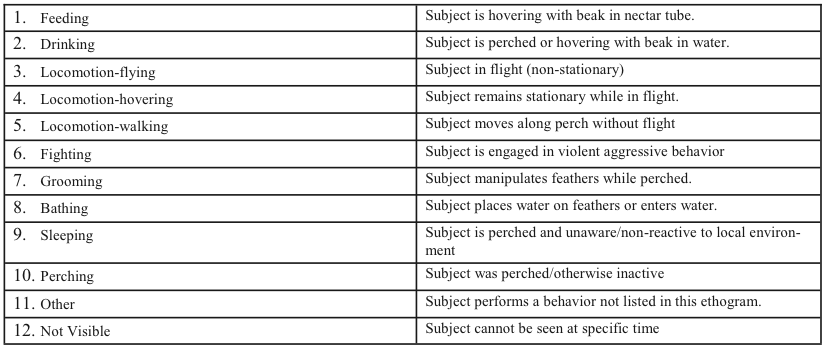From Discussions VOL. 5 NO. 1Adaptations and Preferences of Wild Hummingbirds Introduced into a Captive Setting
IN THIS ARTICLE
KEYWORDS
AbstractThis case study focuses on the effects of avian introductions into a captive exhibit. Two hummingbirds, Colibri coruscans (sparkling violet eared) and Anthracothorax prevostii (green breasted mango), were both observed over an 8 week period as they were reintroduced into a recently remodeled Free Flight Exhibit, located at Perching Bird house of the Brookfield Zoo in Chicago, Illinois. Prior to introduction, the birds were held in isolation holding. In both the zoo and isolation, the subjects were observed on their location, social proximity, and behavior. The questions of whether the subjects would have a preference in location and whether a change in behavior while in captivity were studied. The end result was that both birds showed preferences of location in the exhibit, as well as an increased perching behavior, greater than what is observed in their natural habitats. INTRODUCTIONThe Free Flight exhibit at the Brookfield Zoo is large aviary enclosure that houses several varieties of birds. This enclosure has a wide array of trees and plants that are separated in the middle by a large winding stream that gives the birds, within the exhibit, a wide selection of perches and other necessities. However, recently the exhibit was closed and remodeled. The roof panels were removed and replaced with clear transparent windows to allow sunlight into the exhibit; the walls were repainted to give the impression that the exhibit was on the top of a mountain; and the flora (trees and floor plants) in the exhibit were changed. The end result was a new environment that mirrored an entirely new habitat. The two hummingbirds that were observed for a period of 8 weeks were the male Colibri coruscans and female Anthracothorax prevostii hummingbirds. Both hummingbirds are members of the family Trochilidae and are native to either Central or South America. C. coruscans is characterized by its all green body with stripes of violet around both eyes and is native to North West South America, mainly NW Venezuela and Columbia through Ecuador and Peru to Bolivia and NW Argentina (Campbell 1974). Its particular habitat or niche includes forest edges, open woodland, flowering gardens, and plantations. These habitats are ideal for C. coruscans, as its primary food sources are nectar from flowers and small insects, both of which are abundant in such a tropical region (Perrins 2003). It is known to migrate for food, although this is mainly done during dry seasons. A. prevostii also has an all green body, most noticeable in its breast. Another characteristic of A. prevostii is its decurved bill (Alderfer 2005). A. prevostii is most commonly found in central and the northern South America. It usually inhabits open grassy or shrubby areas with scattered taller trees, especially near water, savannas pastures, parks, gardens, shaded coffee plantations, and other sparsely lowland forests at an elevation between 900-1200 Meters. A. prevostii mainly feeds on the nectar of brightly-hued plants and small insects (Perrins 2003). It is not known to migrate long distances; however, its movements are known to correlate based on the local flora. Figure 1. The Free Flight exhibit at the Brookfield Zoo
The purpose of this case study is to observe the behavior of two of the exhibit's residents, Colibri coruscans (Sparkling violet eared) and Anthracothorax prevostii (Green Breasted Mango) hummingbirds, both while they are in holding, and after they are reintroduced into Free Flight. These observations will focus on monitoring their location within the exhibit, their social proximity to other birds, and their behavior at specific intervals. The purpose of collecting this data is to help answer the questions, ―Do these hummingbirds have particular preferences in terms of habitat within a captive environment?‖ and ―Does captivity drive the actions/ behaviors of these birds? Do they differ from what is witnessed in the wild, and if so why?‖ The end goal is to use the preferences and adaptations of these birds to gain more information about them in a captive setting and understand how to better design exhibits in the future.Continued on Next Page » Suggested Reading from Inquiries Journal
Inquiries Journal provides undergraduate and graduate students around the world a platform for the wide dissemination of academic work over a range of core disciplines. Representing the work of students from hundreds of institutions around the globe, Inquiries Journal's large database of academic articles is completely free. Learn more | Blog | Submit Latest in Biology |





















